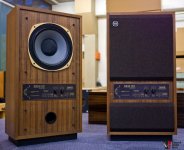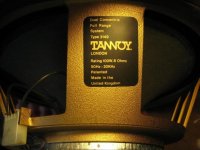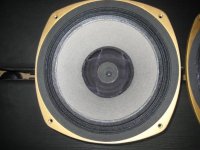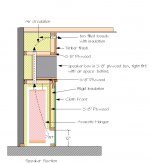Greetings,
Ohh JOY ... !!!
I bought myself a set of Tannoy K3149 speakers (Tannoys Dual Concentric 12") in mint condition. It came with 1 filter and 2 filter frontpanels
and 2 filter frontpanels  .
.
Always wanted Tannoys for my (ever to build) home studio. Now I have this pair, I intend to do a project;
1 - Try to build my own Super Red Monitor cabinets (as close to original as doable)
2 - Design my own version to make it go way more deep, but keep it easy enough to handle.
3 - Build new filters, with the latest and greatest components (affordable prices ?)
4 - Do an active version with miniDSP and class A amps.
Challenges enough, I found a number of web-sites that contain K3149 and Super Red Monitor data, including a schema of the filter used.
To my supprize, the T&S parameters found ALL differ, and not by a margin. I use Bass Box 6 Pro, to design my cabinets (with good results) and it also contains a 12" Tannoy (SRM 12 LF), but it holds a note (caution: These parameters were measured by an unknown source (never knew that an unknown source has this type of talent... ) and may not reflect the original specifications of the driver.). These parameters ALSO differ from the others found, but seem "More logical".
) and may not reflect the original specifications of the driver.). These parameters ALSO differ from the others found, but seem "More logical".
I also found the dimensions of the Super Red Monitor cabinet, 2 sets almost identical, 6 ALL differ, like internal volume between 72 and 105 liters. Doing a conversion to feet 3, AGAIN 3 differ this time. Hmmmmmm, nice little project popping up on the horizon. (or is measuring and calculating way more complex than expected?
(or is measuring and calculating way more complex than expected? 
I gave it a first shot with Bass Bax 6 Pro, using the "unknown source" SRM 12 LF driver and the 2 almost identical dimension specs. Gave a result that looks very much like the specs in the Tannoy brochures I found.
Except to the reflex port, looks small on the picture (compared to the 12" driver it looks more like 50-60 mm), but comes out to be 98,8 mm diameter and 18 mm deep (at Fb 52 Hz).
I could just build these and have a listen, but my goal was to do it VERY right.
So this thread is intended to find all details and show all results, ending in designs for all interested parties (except professional builders, you can find this yourself.).
Any suggestion where to get the REAL T&S specs? to start with. Also saw that Tannoy (and almost any other company at that period) used "particle board" as building material, which we now a days call "any unkind phrase" of wood.
Start will be MDF 18 mm, end will be top grade Birch Plywood. Heavy bracing, etc.
Also noticed VERY thin cabling used, see how that effects the sound quality. These were very popular monitors way back when, change it YES / NO?
Keep you informed....
Oooh , by the way, the picture attached of the complete cabinet of course is just an example of what will be the net result of this project. Duuhhh.
Ohh JOY ... !!!
I bought myself a set of Tannoy K3149 speakers (Tannoys Dual Concentric 12") in mint condition. It came with 1 filter
Always wanted Tannoys for my (ever to build) home studio. Now I have this pair, I intend to do a project;
1 - Try to build my own Super Red Monitor cabinets (as close to original as doable)
2 - Design my own version to make it go way more deep, but keep it easy enough to handle.
3 - Build new filters, with the latest and greatest components (affordable prices ?)
4 - Do an active version with miniDSP and class A amps.
Challenges enough, I found a number of web-sites that contain K3149 and Super Red Monitor data, including a schema of the filter used.
To my supprize, the T&S parameters found ALL differ, and not by a margin. I use Bass Box 6 Pro, to design my cabinets (with good results) and it also contains a 12" Tannoy (SRM 12 LF), but it holds a note (caution: These parameters were measured by an unknown source (never knew that an unknown source has this type of talent...
I also found the dimensions of the Super Red Monitor cabinet, 2 sets almost identical, 6 ALL differ, like internal volume between 72 and 105 liters. Doing a conversion to feet 3, AGAIN 3 differ this time. Hmmmmmm, nice little project popping up on the horizon.
 (or is measuring and calculating way more complex than expected?
(or is measuring and calculating way more complex than expected? I gave it a first shot with Bass Bax 6 Pro, using the "unknown source" SRM 12 LF driver and the 2 almost identical dimension specs. Gave a result that looks very much like the specs in the Tannoy brochures I found.
Except to the reflex port, looks small on the picture (compared to the 12" driver it looks more like 50-60 mm), but comes out to be 98,8 mm diameter and 18 mm deep (at Fb 52 Hz).
I could just build these and have a listen, but my goal was to do it VERY right.
So this thread is intended to find all details and show all results, ending in designs for all interested parties (except professional builders, you can find this yourself.).
Any suggestion where to get the REAL T&S specs? to start with. Also saw that Tannoy (and almost any other company at that period) used "particle board" as building material, which we now a days call "any unkind phrase" of wood.
Start will be MDF 18 mm, end will be top grade Birch Plywood. Heavy bracing, etc.
Also noticed VERY thin cabling used, see how that effects the sound quality. These were very popular monitors way back when, change it YES / NO?
Keep you informed....
Oooh , by the way, the picture attached of the complete cabinet of course is just an example of what will be the net result of this project. Duuhhh.
Attachments
Any suggestion where to get the REAL T&S specs? to start with.
Measuring your own units is the only way to be 'sure' -and since T/S values vary somewhat depending on measuring conditions, that's not '100%' either. Still, it sounds like you're wanting to make a proper job of it, and since you're dealing with rather rare, rather expensive and rather elderly Tannoy units, the relatively small cost of purchasing, say, Woofer Tester 2, 3 or any other inexpensive measurement gear would seem a good investment to my mind. Whatever numbers you find on the 'net or elsewhere may not (probably will not) apply to your units, which will have seen different uses and treatment over the decades, and that will have left its mark on them, like any other mechanical component.
Re cabinets & different volumes -depends on the specific units, and also the goals for the different boxes.
Re thin wire -depends on how thin, how long. If it becomes excessively resistive, there you have power-losses, and it may artificially raise the effective Q. That may result in excessive LF gain vis-à-vis what was intended, which may (or may not) balance off against the wire being unable to handle large currents (bass region), 'clipping' (for want of a better phrase) these relative to the mids & HF.
Last edited:
I gave up looking for a decent 'pair' of 12" red / gold because they're so damn old, beaten and could get damn expensive looking for a 'nearly match' by buying several pairs.
So I spent out on a pair of DC12i's which are new and repeatable should things go wrong.
This thread is interesting (in many ways!): Tannoy ?? ??????? ? ???????? ?? ????? ????
Takes a bit of reading though....
So I spent out on a pair of DC12i's which are new and repeatable should things go wrong.
This thread is interesting (in many ways!): Tannoy ?? ??????? ? ???????? ?? ????? ????
Takes a bit of reading though....
I gave up looking for a decent 'pair' of 12" red / gold because they're so damn old, beaten and could get damn expensive looking for a 'nearly match' by buying several pairs.
So I spent out on a pair of DC12i's which are new and repeatable should things go wrong.
This thread is interesting (in many ways!): Tannoy ?? ??????? ? ???????? ?? ????? ????
Takes a bit of reading though....
These ones are not beaten and were affordable (320 Euro for the pair).
I'll look into your URL, Thanks.
Attachments
I gave up looking for a decent 'pair' of 12" red / gold because they're so damn old, beaten and could get damn expensive looking for a 'nearly match' by buying several pairs.
So I spent out on a pair of DC12i's which are new and repeatable should things go wrong.
Yes but these are not Reds or Golds from the '60s but '80s K series drivers.
While €320 is a very good price true Reds would probably set you back 10x as much.
However every single Tannoy DC starting with Silvers (not sure about Blacks though) can be brought back to as-new factory spec by Lockwood Audio.
This also dramatically increases the thermal power capability of the driver as the originals are limited by the melting point of the glue used to fix the vc to the former and the fact that the former is of the cardboard variety.
This thread is interesting (in many ways!): Tannoy ?? ??????? ? ???????? ?? ????? ????
Takes a bit of reading though....
Sippy,
I already found this URL, good info.
I used the dimensions of the SRM Series owners manual (846 x 446 x 272) with Bass Box 6 Pro and the SRM 12" LF T&S in Bass Box 6 Pro. This came out fine, gave me a 75 liter cabinet, +/- 4 dB point almost as stated in the owners manual, EXCEPT for the reflex port, way off in size, at the Fb 52 dB point. Fb 52 looks like the optimum for this cabinet / driver.
Still a good start
Woofer Tester 2
Get the one from Smith + Larson. Probably the most useful T/S measuring tool short of the expensive stuff they use at the factory.
T/S are not scalars (the numbers you get depend on where on the curve you measure them). That and the changes that happen with age means that one really needs to measure the ones you have.
dave
I assume you know this site:
TANNOY Monitor Gold dual concentric speakers
Yours appear to be SRM12x with an internal volume of 68L.
However the gain over LRM12 (46L) is minimal, two or three Hertz in extension.
To get the most out bass of the K3149 you need a vented 200L cab.
That said I like my LRMs a LOT better since I turned them into 3ways with an additional 12" woofer
covering up to 250Hz. The mid range got audibly cleaner.
I like to think of mine as 12" versions of the Tannoy FSM.
TANNOY Monitor Gold dual concentric speakers
Yours appear to be SRM12x with an internal volume of 68L.
However the gain over LRM12 (46L) is minimal, two or three Hertz in extension.
To get the most out bass of the K3149 you need a vented 200L cab.
That said I like my LRMs a LOT better since I turned them into 3ways with an additional 12" woofer
covering up to 250Hz. The mid range got audibly cleaner.
I like to think of mine as 12" versions of the Tannoy FSM.
Last edited:
Charles,
( Yes, this is the SRM12X version (found 72 liters with Bass Box 6 Pro). You are right about the 200L, using Bass Box 6 Pro, it started to get serious from 140 liters upwards, getting to big cabinets for my studio).
I hear what you say about the Little Red Monitors "LRM" and the idea gets more of my attention by the hour. Maybe, it's an option to go for the Little Red Monitors and add a good sub (a single fold tapped horn / Lets Go crazy here... ). A very solid tapped horn sub is around 2000 x 400 x 400 mm loaded with 2x 12" push-pull config and reaches 30 Hz easily. Laying on the ground, or placed in a corner will produce a solid bang. There are a bunch of tapped horn designs in this web-site.
). A very solid tapped horn sub is around 2000 x 400 x 400 mm loaded with 2x 12" push-pull config and reaches 30 Hz easily. Laying on the ground, or placed in a corner will produce a solid bang. There are a bunch of tapped horn designs in this web-site.
For the future studio, I could do a soffit mount for the LRM's and hide the sub in the corner.
250 Hz seems a bit high, maybe somewhere around 100 - 120 Hz to prevent "hearing" the location of the sub. The LRM cabinet will easily support this setup, regarding the specs (the -4dB point is around 56 Hz, 0dB looks like a fraction above 100 Hz. The system could produce high SPL levels if required, if I would high pass the LRM's. Active filtering for the sub and the LRM (as a total system), passive filtering of the LRM.
I added a drawing for "soffit mounting" for those who are unaware of this studio monitor placement approach. The air behind the box is only required when using active speakers, so I would skip that.
Thanks for the alternative direction idea, that's what I'm looking for here.
( Yes, this is the SRM12X version (found 72 liters with Bass Box 6 Pro). You are right about the 200L, using Bass Box 6 Pro, it started to get serious from 140 liters upwards, getting to big cabinets for my studio).
I hear what you say about the Little Red Monitors "LRM" and the idea gets more of my attention by the hour. Maybe, it's an option to go for the Little Red Monitors and add a good sub (a single fold tapped horn / Lets Go crazy here...
For the future studio, I could do a soffit mount for the LRM's and hide the sub in the corner.
250 Hz seems a bit high, maybe somewhere around 100 - 120 Hz to prevent "hearing" the location of the sub. The LRM cabinet will easily support this setup, regarding the specs (the -4dB point is around 56 Hz, 0dB looks like a fraction above 100 Hz. The system could produce high SPL levels if required, if I would high pass the LRM's. Active filtering for the sub and the LRM (as a total system), passive filtering of the LRM.
I added a drawing for "soffit mounting" for those who are unaware of this studio monitor placement approach. The air behind the box is only required when using active speakers, so I would skip that.
Thanks for the alternative direction idea, that's what I'm looking for here.
Attachments
If you cross at 160Hz or above you can put the Tannoys into relatively small sealed cabs.
Which is why I prefer a 3way approach over subs. Fairly easy to keep the woofers within 1/4 wavelength of the Tannoys so the whole is just as point-sourcey as before.
I use Volt RV3143 in T/Ls as woofers which are a decent match to the DCs IMO.
Which is why I prefer a 3way approach over subs. Fairly easy to keep the woofers within 1/4 wavelength of the Tannoys so the whole is just as point-sourcey as before.
I use Volt RV3143 in T/Ls as woofers which are a decent match to the DCs IMO.
Last edited:
Speaker measuring
Okay,
I decided to follow the advice and buy myself a measurement tool for the K3149 (and future speaker I will use in other projects).
Found 2 that OK for the price (around 125 euro);
- DATS 2 (Dayton Audio DATS V2 Computer Based Audio Component Test System)
- Smith & Larson WT2 (Woofer tester 2).
Any experience, votes?
Okay,
I decided to follow the advice and buy myself a measurement tool for the K3149 (and future speaker I will use in other projects).
Found 2 that OK for the price (around 125 euro);
- DATS 2 (Dayton Audio DATS V2 Computer Based Audio Component Test System)
- Smith & Larson WT2 (Woofer tester 2).
Any experience, votes?
If you cross at 160Hz or above you can put the Tannoys into relatively small sealed cabs.
Which is why I prefer a 3way approach over subs. Fairly easy to keep the woofers within 1/4 wavelength of the Tannoys so the whole is just as point-sourcey as before.
I use Volt RV3143 in T/Ls as woofers which are a decent match to the DCs IMO.
Hi Charles,
Did have a peek at the Volt speaker, serious stuff.
I like your approach, maybe this will be the "alternative studio monitor".
A Transmission Line or Vented enclosure with the Volt 12" including a sealed enclosure INSIDE this box to house the Tannoy K3149. A closed box of 20 liters will give a nice roll-off @ 160Hz for the Tannoy, minimizing the additional volume for the complete enclosure. Gives a box of around 120 liters with serious specs and a doable passive filter (or maybe active 3-way with digital amps).
So this will give a 2x 12" full range monitor in a very acceptable monitor size.
Never designed or build a Transmission line, that adds to the learning curve here
Thanks.
- DATS 2 (Dayton Audio DATS V2 Computer Based Audio Component Test System)
- Smith & Larson WT2 (Woofer tester 2).
The S+L WT2 is by far the superior product.
dave
wae I'm running mine analogue active with a couple of BSS xovers and a parametric eq to get transfer function right for the Tannoy tweeter. Amps are all MC2 Audio. I will never run out of clean power! ;-)
Work quite well together IMO.
However the T/L for the Volts will be quite large. Mine came to about 140L internal or about the same as the PMC XB2.
One thing you learn when building a T/L for certain is how to open up the cab and adjust the stuffing! Vented cabs are much more predictable but to my ears T/Ls work better at lowish volumes.
Vented cabs are much more predictable but to my ears T/Ls work better at lowish volumes.
Work quite well together IMO.
However the T/L for the Volts will be quite large. Mine came to about 140L internal or about the same as the PMC XB2.
One thing you learn when building a T/L for certain is how to open up the cab and adjust the stuffing!
Documentation
Yes I'm still alive, mostly kicking...
I've found a number of documents on the WWW, the longer you dig, the more pops up. What a great place to be (well depends what you need ).
).
The cross-over diagram shows a kind of transformer as a kind of L-pad implementation. Don't have a clue yet on windings and wire used. For the cross-over I think I am going do build complete new ones with state-of-the-art components and sets of resisters for HF attenuation.
Yes I'm still alive, mostly kicking...
I've found a number of documents on the WWW, the longer you dig, the more pops up. What a great place to be (well depends what you need
The cross-over diagram shows a kind of transformer as a kind of L-pad implementation. Don't have a clue yet on windings and wire used. For the cross-over I think I am going do build complete new ones with state-of-the-art components and sets of resisters for HF attenuation.
Attachments
Design of the SRM12x (only the beginning)
I did a first guess based on documentation found, these values must be correct.
The bass reflex port of course is under construction, don't have the T/S parameters yet. (I did send 2 Emails to "sales@woofertester.com, no reply yet). Hope they are alive and I can get this woofer tester so I can measure the units and calculate the reflex port. On the pictures, they look kind of smallish. I read an article stating that a base rule for bass-reflex ports is ⅓ the diameter of the driver. Makes me wonder if that is not a bit on the "oversized" part of the spectrum. Anyway, more to come.
In case someone in the house knows the size, count me in to tell.
Ooh, by the way, "only the beginning" was a song of the band Chicago, way back when.. (Yes I know, I'm getting old )
)
I did a first guess based on documentation found, these values must be correct.
The bass reflex port of course is under construction, don't have the T/S parameters yet. (I did send 2 Emails to "sales@woofertester.com, no reply yet). Hope they are alive and I can get this woofer tester so I can measure the units and calculate the reflex port. On the pictures, they look kind of smallish. I read an article stating that a base rule for bass-reflex ports is ⅓ the diameter of the driver. Makes me wonder if that is not a bit on the "oversized" part of the spectrum. Anyway, more to come.
In case someone in the house knows the size, count me in to tell.
Ooh, by the way, "only the beginning" was a song of the band Chicago, way back when.. (Yes I know, I'm getting old
 )
)Attachments
That thing in the xover diagram is an autoformer which is not commercially available.
Somebody in the Tannoy Yahoo group may have the values and than you could get one custom-wound for you. Not cheap though...
Alternatively there is a crossover for the 3149 as used in the DC4000 which does not use an autoformer. Schematic should also be available through aforementioned Yahoo group.
Somebody in the Tannoy Yahoo group may have the values and than you could get one custom-wound for you. Not cheap though...
Alternatively there is a crossover for the 3149 as used in the DC4000 which does not use an autoformer. Schematic should also be available through aforementioned Yahoo group.
There are wall-mounted volume controls for installing in houses that essentially are auto-transformers inside. Not likely to have the same inductance as what you are copying, but probably are usable with some changes.
Such as...
https://www.parts-express.com/atlas-sound-at35-35w-auto-transformer-speaker-volume-control-stainless-steel--242-872
https://www.parts-express.com/cat/attenuators-auto-transformers/234
Such as...
https://www.parts-express.com/atlas-sound-at35-35w-auto-transformer-speaker-volume-control-stainless-steel--242-872
https://www.parts-express.com/cat/attenuators-auto-transformers/234
Last edited:
- Home
- Loudspeakers
- Multi-Way
- Tannoy Super Red Monitor Project




